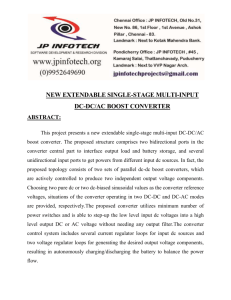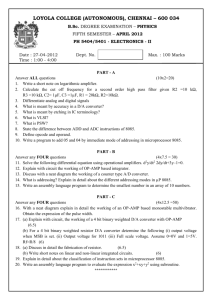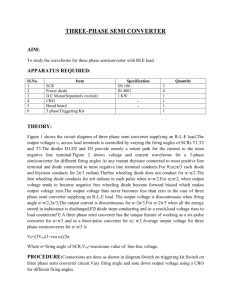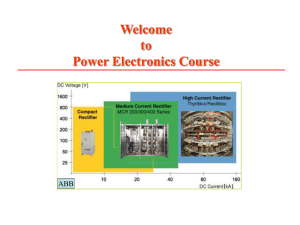The CIGRE B4 DC Grid Test System
advertisement
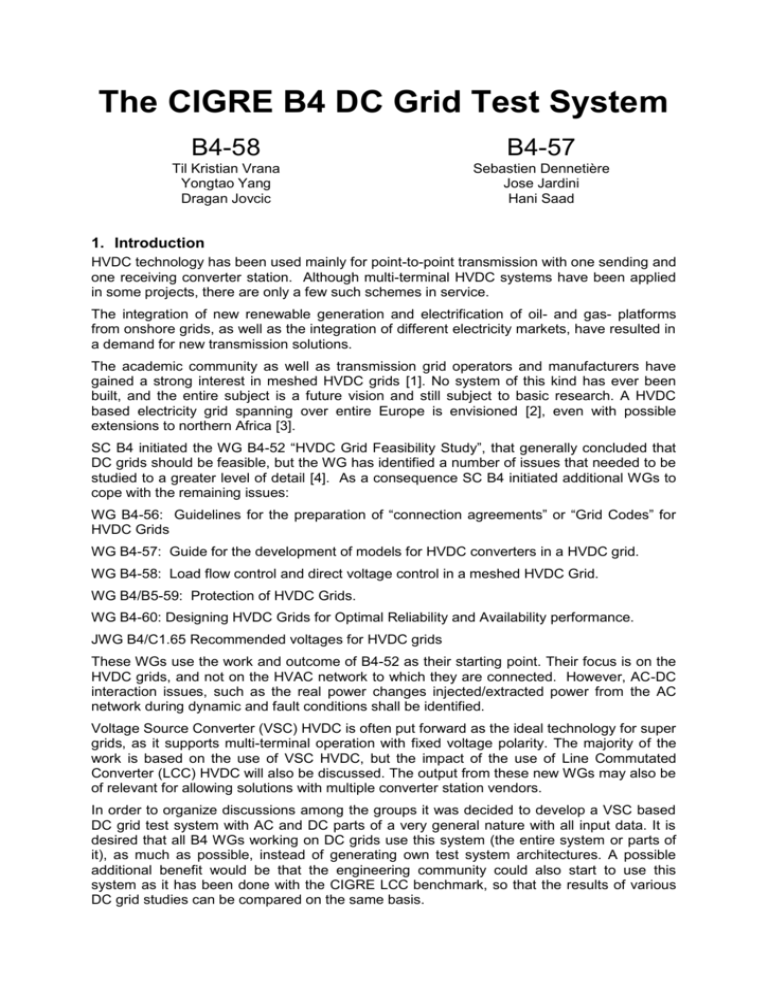
The CIGRE B4 DC Grid Test System B4-58 B4-57 Til Kristian Vrana Yongtao Yang Dragan Jovcic Sebastien Dennetière Jose Jardini Hani Saad 1. Introduction HVDC technology has been used mainly for point-to-point transmission with one sending and one receiving converter station. Although multi-terminal HVDC systems have been applied in some projects, there are only a few such schemes in service. The integration of new renewable generation and electrification of oil- and gas- platforms from onshore grids, as well as the integration of different electricity markets, have resulted in a demand for new transmission solutions. The academic community as well as transmission grid operators and manufacturers have gained a strong interest in meshed HVDC grids [1]. No system of this kind has ever been built, and the entire subject is a future vision and still subject to basic research. A HVDC based electricity grid spanning over entire Europe is envisioned [2], even with possible extensions to northern Africa [3]. SC B4 initiated the WG B4-52 “HVDC Grid Feasibility Study”, that generally concluded that DC grids should be feasible, but the WG has identified a number of issues that needed to be studied to a greater level of detail [4]. As a consequence SC B4 initiated additional WGs to cope with the remaining issues: WG B4-56: Guidelines for the preparation of “connection agreements” or “Grid Codes” for HVDC Grids WG B4-57: Guide for the development of models for HVDC converters in a HVDC grid. WG B4-58: Load flow control and direct voltage control in a meshed HVDC Grid. WG B4/B5-59: Protection of HVDC Grids. WG B4-60: Designing HVDC Grids for Optimal Reliability and Availability performance. JWG B4/C1.65 Recommended voltages for HVDC grids These WGs use the work and outcome of B4-52 as their starting point. Their focus is on the HVDC grids, and not on the HVAC network to which they are connected. However, AC-DC interaction issues, such as the real power changes injected/extracted power from the AC network during dynamic and fault conditions shall be identified. Voltage Source Converter (VSC) HVDC is often put forward as the ideal technology for super grids, as it supports multi-terminal operation with fixed voltage polarity. The majority of the work is based on the use of VSC HVDC, but the impact of the use of Line Commutated Converter (LCC) HVDC will also be discussed. The output from these new WGs may also be of relevant for allowing solutions with multiple converter station vendors. In order to organize discussions among the groups it was decided to develop a VSC based DC grid test system with AC and DC parts of a very general nature with all input data. It is desired that all B4 WGs working on DC grids use this system (the entire system or parts of it), as much as possible, instead of generating own test system architectures. A possible additional benefit would be that the engineering community could also start to use this system as it has been done with the CIGRE LCC benchmark, so that the results of various DC grid studies can be compared on the same basis. 2. System Description In this article a DC grid test system is proposed and the basic configuration is presented in Figure 1. The complete system is composed of: 2 onshore AC systems o System A (A0 and A1) o System B (B0, B1, B2 and B3) 4 offshore AC systems o System C (C1 and C2) o System D (D1) o System E (E1) o System F (F1) 2 DC nodes, with no connection to AC o B4 o B5 3 VSC-DC systems o DCS1 (A1 and C1) o DCS2 (B2, B3, B5, F1 and E1) o DCS3 (A1, C2, D1, E1, B1, B4 and B2) Figure 1 DC Grid Test System Basic Configuration A more detailed presentation of the test system is shown in Figure 2. All line lengths are given in km. A line drawn in Figure 2 represents a line circuit meaning 3 lines for AC and 2 lines for DC. Onshore AC busses are called “Ba”, offshore AC busses “Bo”, sym. monopole DC busses “Bm”, bipole DC busses “Bb”, monopole AC-DC converter stations “Cm”, bipole AC-DC converter stations “Cb” and DC-DC converter stations “Cd”. AC System A consists of two busses, bus Ba-A1 where two AC-DC converters are located and slack bus Ba-A0 representing the rest of system A. System A has an active power surplus and exports electric power. AC system B consists of four busses, Ba-B1, Ba-B2 and Ba-B3 being connected to AC-DC converters and slack bus Ba-B0 representing the rest of system B. AC System B imports active power. AC systems C, D and F are offshore wind power plants and AC system E is an offshore load (oil & gas platform). DCS1 is a 2-terminal symmetric monopole HVDC link (+/-200kV). It connects the offshore wind power plant at C1 to the onshore node A1. DCS2 is a 4-terminal symmetric monopole HVDC system (+/-200kV). It connects the offshore wind power plant at F1 and the offshore oil & gas platform at E1 to the onshore node B3 and extends further inland to a load centre B2. This system consists of overhead lines and cables in series, to be able to capture possible interactions of those different line types (wave reflections, etc.) DCS3 is a 5-terminal bipole HVDC meshed grid (+/-400kV). DCS3 contains a DC-DC converter at B1 for power flow control. All three direct current systems are based on VSC technology. The two voltages (200kV and 400kV) are nominal voltages and they represent 1pu voltage. The operational frame for the direct current systems has the upper limit at 1.05pu and the lower limit at 0.95pu. There is no direct connection between DCS1 and DCS2. DCS1 and DCS3 are interconnected through AC node at A1 (and somehow also through system C). DCS2 and DCS3 are interconnected through a DC-DC converter station at E1 and through an AC node at B2. DC Sym. Monopole DC Bipole Ba-A0 AC Onshore AC Offshore Cable Overhead line Cm-A1 Bm-A1 Bm-C1 DCS1 Cm-C1 Bo-C1 200 200 Ba-A1 Bb-A1 Bb-C2 Cb-A1 AC-DC Converter Station DC-DC Converter Station Cb-C2 50 200 Bo-C2 300 500 400 Cb-D1 Bb-D1 DCS3 Bo-D1 200 200 Bb-B4 Ba-B0 Ba-B1 Bb-B1 Bb-B1s Bb-E1 200 200 Cd-E1 Cb-B1 Cd-B1 Bm-E1 300 200 Bo-E1 200 Cm-E1 200 Cb-B2 200 Bb-B2 DCS2 Ba-B2 200 Bm-B3 Cm-B2 Bm-B2 100 200 Cm-B3 Bm-B5 Bm-F1 Bo-F1 100 Cm-F1 Ba-B3 Figure 2 CIGRE B4 DC Grid Test System Any of these 3 DCSs can be used separately for tasks where the full test system is too complex. The DC-DC converter station within DCS3 at B1 can be bypassed if that is desired (it changes the power flow). The DC-DC converter station that connects DCS2 and DCS3 at E1 cannot be bypassed but it can be removed (disconnecting DCS2 and DCS3 at E1). A monopole AC-DC converter station consists of one AC-DC converter pole (shown in section 4 of this article). A bipole AC-DC converter station consists of two AC-DC converter poles. This is shown in Figure 3. The bipole DC voltage is twice as high as the symmetric monopole DC voltage, giving all converter poles in the system the same DC voltage (to make modelling easier). Figure 3 Bipole converter station Average value models1 for electromechanical transient studies are given in this article. More detailed electromagnetic transient models will be given in the technical brochure B4-57. The AC systems operate at 50Hz. All AC voltages in this article are given as Line-to-Line RMS voltage. The active power reference used in this article is that loads are positive active power. For power converters, transfer from the side with measured voltage (𝑉𝑚 -side) to the side with controlled voltage (𝑉𝑐 -side) is positive active power. For an AC-DC converter this means from DC to AC. The focus of the system is to study the DC systems and the converter control. Therefore it was decided to not model the AC generators and loads in detail in the first instance and they are simply represented by constant active power sources and sinks (given in Table 2). Only symmetric operation is regarded, so all ground currents are zero. All data given refers to positive sequence. For simulation grounded neutral can be utilised although a real future system probably will have a dedicated metallic return. 3. Basic system data for power flow 3.1. System Data Table 1 gives the voltages of the different subsystems and Table 2 AC bus data. System AC Onshore AC Offshore DC Sym. Monopole DC Bipole Voltage [kV] 380 145 +/-200 +/-400 Table 1: System data 1 In the AC systems, average value model is also referred to as “phasor domain model”. Bus Bus Type Ba-A0 Ba-A1 Ba-B0 Ba-B1 Ba-B2 Ba-B3 Ba-C1 Ba-C2 Ba-D1 Ba-E1 Ba-F1 Slack Bus PQ Slack Bus PQ PQ PQ PQ PQ PQ PQ PQ Generation [MW] -2000 -1000 -1000 -1000 -500 -500 -1000 0 -500 Load [MW] 1000 2200 2300 1900 0 0 0 100 0 Table 2: AC bus data 3.2. AC-DC Converter Station Data Table 3, Table 4 and Table 5 give the data for all the AC-DC converter stations. AC-DC Converter Station Cm-A1 Cm-C1 Power Rating [MVA] 800 800 Operation Mode Setpoints VDC = 1pu Q=0 AC Slack Power Rating [MVA] 800 Operation Mode Setpoints VDC = 0.99pu Q=0 VAC = 1pu P = 800MW AC Slack AC Slack Table 3: DCS1 data AC-DC Converter Station Cm-B2 Cm-B3 Cm-E1 Cm-F1 1200 200 800 Table 4: DCS2 data AC-DC Converter Station Cb-A1 Cb-B1 Cb-B2 Cb-C2 Cb-D1 Power Rating [MVA] 2*1200 2*1200 2*1200 2*400 2*800 Operation Mode Setpoints VAC = 1pu VDC = 1.01pu VAC = 1pu P = 1500MW VAC = 1pu P = 1700MW VAC = 1pu P = - 600MW AC Slack Table 5: DCS3 data 3.3. DC-DC Converter Station Data Table 6 gives the data for the DC-DC converter stations. DC-DC Converter Station Cd-B1 Cd-E1 Power Rating [MW] 2000 1000 Operation Mode Setpoints P = 600MW P = 300MW Table 6: DC-DC converter data 3.4. Data for calculation of the losses The line data for calculating the power flow can be found in Section 0. 4. Power Flow An approximate power flow is presented in Figure 4. 380 -618.14 380 -1000 A0 386.27 201.87 200 390.70 145 -500 A1 618.00 106.50 404 Sym. Monopole DC Voltage Bipole DC Voltage Converter Power Transfer Line Power Infeed Onshore AC Voltage Offshore AC Voltage AC Load - Generation 405.60 -600 -1981.18 683.56 C2 979.28 B4 145 -500 84.42 1681.18 405.89 D1 -993.75 145 -1000 907.73 380 447.73 C1 -391.50 759.51 397.10 399.26 1500 188.42 402.33 403.76 300 B0 380 1200 1717.88 B1 602.64 600 102.82 175.26 1700 380 E1 202.29 198.22 100.50 201.36 F1 145 100 393.40 B2 1300 -122.55 198 86.22 Figure 4 Approximate power flow B3 121.75 800 89.37 197.43 B5 199.72 687.66 380 900 693.37 145 -496.88 -500 5. Average Value Models for Electromechanical Transient Studies 5.1. AC-DC converter pole The AC-DC converter pole model consists of one ideal AC-DC converter, one ideal transformer and 4 passive elements. The AC-DC converter is modelled as a current source on the DC side behind a capacitor and a voltage source on the AC side behind an inductor. The transformer is modelled as an ideal transformer. Transformer and converter have the same MVA rating. The model of an AC-DC converter pole is presented in Figure 5. Figure 5 Average value model of the AC-DC converter pole All converters operate on 400kV DC voltage and 220kV AC voltage. The AC voltage at the Point of Common Coupling (PCC) can be either 380kV (onshore) or 145kV (offshore), but this only influences the ratio of the ideal transformer while it does not influence the rest of the converter pole model. The model has been selected for easy implementation in average value model simulation software, even though it is not giving an exact representation of modern MMC (Modular Multilevel Converter) technology. A basic description of MMC topology is proposed in the appendix. Detailed models suitable for EMT simulation tools will be described in the technical brochure of WG B4-57. Some descriptions of EMT models are available in [5], [6] and [7]. All given values in pu are referring to a local converter pu system and are based on a real project presented in [5]. DC values are given with reference to DC pu. As the system frequency for the DC system is zero, L and C are not behaving like reactances but like integrators. Their pu value is therefore not expressed in “%” with respect to the base impedance but as time constants in “ms”. The time constant of a capacitor expresses the time it takes to charge the capacitor to reference voltage with the reference current (the definition for an inductor is equivalent).The values for converters are given in two different pu systems, one for each side. Inductance values proposed in Table 7: is composed of converter transformer inductance (18%) plus half the converter arm inductance (15% /2). The reference voltages are: VAC,ref = VAC,con = 220kV and VDC,ref = VDC = 400kV. The following formulae are used to calculate the physical values: 𝑍 1 1 𝐿 = 𝐿𝑝𝑢 ∙ 𝐴𝐶,𝑟𝑒𝑓 𝑅 = 𝑅𝑝𝑢 ∙ 𝑍𝐴𝐶,𝑟𝑒𝑓 𝐺 = 𝐺𝑝𝑢 ∙ 𝐶 = 𝐶𝑝𝑢 ∙ 𝜔𝑟𝑒𝑓 pu S L R G C 2 1.0 25.5% 1.00% 0.10% 60ms 𝑍𝐷𝐶,𝑟𝑒𝑓 E1 200MVA 196mH 2.420Ω 1.25µS 75µF C2 400MVA 98mH 1.210Ω 2.50µS 150µF A1, B2, C1, D1, F1 800MVA 49mH 0.605Ω 5.00µS 300µF 𝑍𝐷𝐶,𝑟𝑒𝑓 A1, B1, B2, B3 1200MVA 33mH 0.403Ω 7.50µS 450µF Table 7: General AC-DC converter pole data 2 The equivalent capacitance value is based on a 1000MVA project with the following approximate data : Vdc = +/-320 kV, Submodule capacitance CSM=10mF, Number of submodules per half arm : 400. C = 6*CSM/N = 150 µF or 60 ms in pu 5.2. DC-DC converter station The DC-DC converter station consists of an ideal DC-DC converter and 4 passive elements. The DC-DC converter is modelled as a current source behind a capacitor on the side where voltage is measured (𝑉𝑚 -side, generally the side with higher voltage) and as a voltage source behind an inductor on the side where voltage is controlled (𝑉𝑐 -side, generally the side with lower voltage). The model of a DC-DC converter station is given in Figure 6. Figure 6 Model of the DC-DC converter station The offshore DC-DC converter at E1 operates at 800kV on the 𝑉𝑚 -side and at 400kV on the 𝑉𝑐 -side. The onshore DC-DC converter at B1 operates at 800kV on both sides. Table 8 shows the DC-DC converter data. S L R G C pu 1.0 5ms 1,200% 0,025% 5ms E1 1000MW 800mH 1,92Ω 0,390625µS 7,8125µF B1 2000MW 1600mH 3,84Ω 0,78125µS 15,625µF Table 8: General DC-DC converter station data 5.3. Lines and cables The test systems contain AC and DC cables and overhead lines. The R-L-G-C parameters needed for average value simulation are given in Table 9. These parameters are calculated with the CABLE DATA and LINE DATA routines based on the detailed description, which will be published in the technical brochure B4-57. AC lines are represented by 50Hz data and DC lines by DC data. Line Data DC OHL +/- 400kV DC OHL +/- 200kV DC cable +/-400kV DC cable +/-200kV AC cable 145kV AC OHL 380kV R [Ω/km] 0.0114 0.0133 0.0095 0.0095 0.0843 0.0200 L [mH/km] 0.9356 0.8273 2.1120 2.1110 0.2526 0.8532 C [µF/km] 0.0123 0.0139 0.1906 0.2104 0.1837 0.0135 G [µS/km] 0.048 0.062 0.041 - Max. current [A] 3500 3000 2265 1962 715 3555 Table 9: Line data for average value model simulation 5.4. AC Slack Busses AC slack busses are modelled as voltage source with R-L impedance. The parameters are given in Table 10. S X/R T λ V 30GVA 10 15s 15MW/mHz 380kV Table 10 Slack bus data 6. Control 6.1. AC-DC Converter A high level view of the control system hierarchy is presented in Figure 7. Upper level controls : P, Q, Vac, Vdc, freq Vabcref Lower level controls : Circulating current suppression, capacitors voltage balancing, firings,... Firings Figure 7 High level description of control system for MMC technology Upper level controls depend on the type of AC system connected to converter; Basically 2 types of upper level controls are available: Non-islanded mode controls when the converter is connected to a strong AC system with active synchronous generation, Islanded mode controls when the converter is connected to passive loads or AC system with a limited short circuit power ratio and inertia (e.g.: weak AC grid, wind farm). With islanded mode controls the converter has an active role in the AC system frequency. Upper level controls generate AC voltages reference values with a fixed magnitude and phase angle. A simplified view of the control system for non-islanded mode is presented in Figure 8. Vdcset + - Kdroop Vdc Vdcmes Pset + - PI - P(Vdc) droop control or P control when Kdroop Vdc = 0 id1ref Pmes + Vdcref PI Vdcmes Vdc control Vacset + Kdroop Vac Vacmes Qset + - PI Q(Vac) droop control or Q control when Kdroop Vac = 0 - iq1ref Qmes Vacset + Vac control PI - Vacmes Vabcmes id1ref iq1ref PLL imax idq1ref q idref Decoupled iqref current idref Vabcref control iqref Current limiter Idmes Iqmes Figure 8 General description of converters upper level control system for non-islanded mode The VSC-type uses a vector control strategy that calculates a voltage time area across the transformer/converter equivalent reactor which is required to change the current from present value to the reference value. The dq0-frame current orders to the controller are calculated from preset P_set and Q_set powers, and preset Q_set and V_set voltages. The inner controller (Decoupled current controller [8]) permits controlling the converter ac voltage that will be used to generate the modulated switching pattern. The control parameters of all AC-DC converters are given in Table 11, Table 12 and Table 13. AC-DC Converter Station Cm-A1 Cm-C1 Control Mode VDC Q AC Slack Table 11 DCS1 control data AC-DC Converter Station Cm-B2 Cm-B3 Cm-E1 Cm-F1 Control Mode VAC droop [pu ; MVAr/kV] VDC droop [pu ; MW/kV] Q(VAC) P(VDC) Q(VAC) P(VDC) AC Slack AC Slack 10 ; 21.053 10 ; 31.579 - 10 ; 40 10 ; 60 - Table 12 DCS2 control data AC-DC Converter Station Cb-A1 Cb-B1 Cb-B2 Cb-C2 Cb-D1 Control Mode VAC droop [pu ; MVAr/kV] VDC droop [pu ; MW/kV] Q(VAC) P(VDC) Q(VAC) P(VDC) Q(VAC) P(VDC) VAC P AC Slack 10 ; 63.158 10 ; 63.158 10 ; 63.158 - 10 ; 60 10 ; 60 10 ; 60 - Table 13 DCS3 control data The droop controllers must be implemented with a power reference and voltage reference being equal to the value achieved in the power flow calculation using the references from the operation mode given in Section 3 of this article. 6.2. DC-DC Converter The DC-DC converters are controlled using a constant voltage ratio (defined 𝐷 = 𝑉𝑐 / 𝑉𝑚 ). This voltage ratio is determined from the initialisation procedure to achieve the correct power transfer set-point, as given in Table 6. Calculated values for the voltage ratio, based on the power flow in Figure 4, are given in Table 14. DC-DC Converter Station Cd-B1 Cd-E1 Control Mode [%] D D D 99,595% 50,280% Table 14 DCDC converter control data As the converter is ideal, and all imperfections (e.g. losses) are represented by the external RLGC components, the current ratio is 1/𝐷. 7. Conclusion The CIGRE B4 DC Grid Test System has been designed by working groups B4-58 and B4-57. Its purpose is to have a common reference for studies concerning DC grids, within but also outside CIGRE B4. The initial results of power flow are presented which confirm steadystate operation and small signal stability. DC grids is a very recent research subject, and due to a lack of operational experience and data, it would be too early to define a benchmark system. The test system can however still serve as a common reference but it can also be adopted for individual studies, if that is needed. Appendix on MMC Figure 9 Simplified view of MMC topology and control principle A MMC consists of 6 arms with arm reactors. Each arm behaves as a controllable voltage source with a high number of possible discrete voltage steps. Each of these controllable voltage sources is composed of a large number (between several tenths to several hundred) of submodules connected in series. The large number of step allows generating a practically pure sinusoidal waveform from the DC voltage. This is shown in Figure 9. Acknowledgement The authors would like to thank the members of CIGRE study groups B4-57 and B4-58 for their comments and contributions, especially Andrew Isaacs, Carl Barker and Jef Beerten. Special thanks also to Philippe Adam for initiating the activities on the CIGRE B4 DC Grid Test System. References [1] D. Van Hertem, M. Ghandhari, ‘Multi-terminal VSC HVDC for the European supergrid: Obstacles’, Renewable & Sustainable Energy Reviews, vol. 14, no. 9, 2010. [2] ‘Position paper on the EC Communication for a European Infrastructure Package’, Friends of the Supergrid, December 2010. [3] ‘Energy from deserts’, Report, Desertec Industrial Initiative, November 2011. [4] CIGRE WG B4.52 “Feasibility of HVDC grids” CIGRE technical brochure 533, Paris, April 2013. [5] J. Peralta, H. Saad, S. Dennetière, J. Mahseredjian, and S. Nguefeu, “Detailed and Averaged Models for a 401-level MMC-HVDC system,” IEEE Trans. on Power Delivery, vol. 27, no. 3, July 2012, pp. 1501-1508. [6] Gnanarathna U., Gole A. & Jayasinghe R., "Efficient Modelling of Modular Multilevel HVDC Converters (MMC) on Electromagnetic Transient Simulation Programs", IEEE Transactions on Power Delivery, Vol. 26, Pages 316 -324, January, 2011. [7] P. Le-Huy, P. Giroux, J.-C. Soumagne, "Real-Time Simulation of Modular Multilevel Converters for Network Integration Studies", International Conference on Power Systems Transients, Delft, The Netherlands, June 2011. [8] A. Lindberg, “PWM and Control of Two and Three level High Power Voltage Source Converters,” Licentiate Thesis, Royal Institute of Technology, Stockholm, Sweden, 1995.


